Themed collection Editor’s Choice: Optical Spectroscopy of 2D materials

Review on the Raman spectroscopy of different types of layered materials
Raman spectroscopy continues to stimulate the explorations on different types of layered materials.
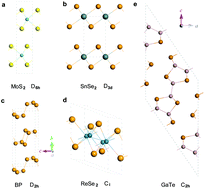
Nanoscale, 2016,8, 6435-6450
https://doi.org/10.1039/C5NR07205K
Anomalous lattice vibrations of CVD-grown monolayer MoS2 probed using linear polarized excitation light
Anomalous lattice vibrations are observed in CVD-grown monolayer MoS2 when rotating the sample and using the linear polarization incident light.
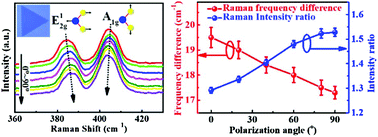
Nanoscale, 2019,11, 13725-13730
https://doi.org/10.1039/C9NR03203G
Hybridized intervalley moiré excitons and flat bands in twisted WSe2 bilayers
Twisted WSe2 bilayers exhibit hybridized K–Λ excitons with flat moiré bands, which become visible through phonon-assisted photoluminescence.
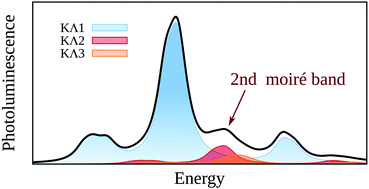
Nanoscale, 2020,12, 11088-11094
https://doi.org/10.1039/D0NR02160A
Realising biaxial reinforcement via orientation-induced anisotropic swelling in graphene-based elastomers
The orientation of graphene contributed to anisotropic reinforcement, since swelling was restrained in the in-plane direction. The Raman study of the 2D band shift of GNPs under biaxial strain revealed the effective biaxial modulus of graphene.
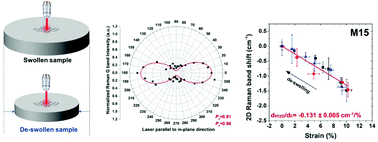
Nanoscale, 2020,12, 3377-3386
https://doi.org/10.1039/C9NR09988C
Stress transfer at the nanoscale on graphene ribbons of regular geometry
Experimental and theoretical investigation of true axial stress transfer on regular-exfoliated-graphene micro-ribbons which are aligned to the loading direction.
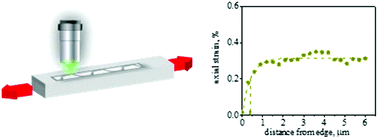
Nanoscale, 2019,11, 14354-14361
https://doi.org/10.1039/C9NR03166A
Scanning tunneling microscopy and Raman evidence of silicene nanosheets intercalated into graphite surfaces at room temperature
(a) STM image of a graphite (G) substrate after the Si deposition at RT. (b) Stable configuration of a silicene nanosheet intercalated under the outmost G layer and (c) this outmost G layer distribution of the tensile strain.
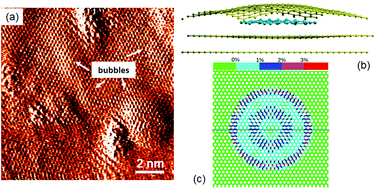
Nanoscale, 2019,11, 6145-6152
https://doi.org/10.1039/C9NR00343F
Exciton and phonon dynamics in highly aligned 7-atom wide armchair graphene nanoribbons as seen by time-resolved spontaneous Raman scattering
Time-resolved spontaneous Raman experiments on 7-AGNRs show the presence of a long lived excitonic dark state together with short and long lived trap states.
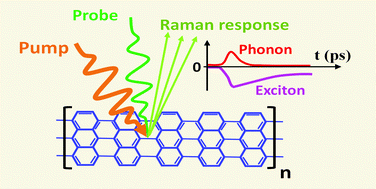
Nanoscale, 2018,10, 17975-17982
https://doi.org/10.1039/C8NR05950K
Stokes and anti-Stokes Raman scattering in mono- and bilayer graphene
The 2D mode of graphene exhibits significant frequency discrepancies between its Stokes and anti-Stokes components, making it possible to probe the nonlinear phonon dispersion of the iTO branch near K.
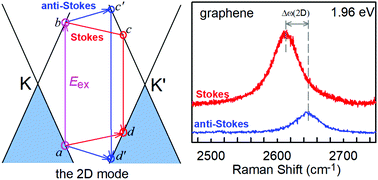
Nanoscale, 2018,10, 16138-16144
https://doi.org/10.1039/C8NR04554B
Probing the nanoscale light emission properties of a CVD-grown MoS2 monolayer by tip-enhanced photoluminescence
The concurrent analysis of the morphological and optical properties demonstrates that TEPL is a unique tool to study 2D materials at the nanoscale.
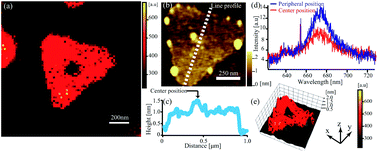
Nanoscale, 2018,10, 14055-14059
https://doi.org/10.1039/C8NR02421A
Remote excitation and detection of surface-enhanced Raman scattering from graphene
We demonstrate the remote excitation and detection of surface-enhanced Raman scattering (SERS) from graphene using a silver nanowire as a plasmonic waveguide.
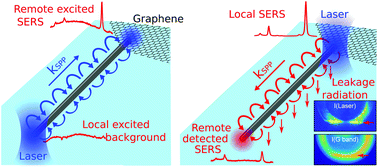
Nanoscale, 2018,10, 10498-10504
https://doi.org/10.1039/C8NR02174K
Near-field exciton imaging of chemically treated MoS2 monolayers
Modification of local exciton emission in monolayer MoS2 by chemical treatments is spatially uneven as revealed by near field imaging.
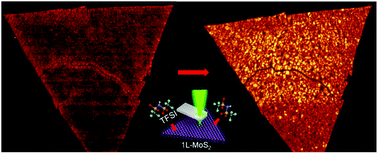
Nanoscale, 2018,10, 8851-8858
https://doi.org/10.1039/C8NR00606G
Resolving the optical anisotropy of low-symmetry 2D materials
Azimuthal-dependence reflectance difference microscopy was developed to visualize and characterize the optical anisotropy of low-symmetry 2D materials.
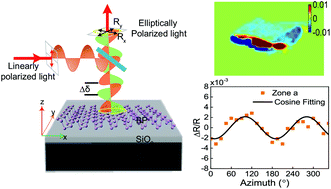
Nanoscale, 2018,10, 8329-8337
https://doi.org/10.1039/C7NR09173G
Giant gap-plasmon tip-enhanced Raman scattering of MoS2 monolayers on Au nanocluster arrays
In this article, we present the results of a gap-plasmon tip-enhanced Raman scattering study of MoS2 monolayers deposited on a periodic array of Au nanostructures on a silicon substrate forming a two dimensional (2D) crystal/plasmonic heterostructure.
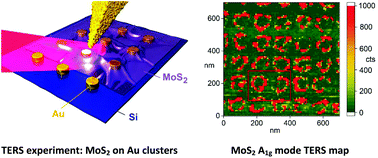
Nanoscale, 2018,10, 2755-2763
https://doi.org/10.1039/C7NR06640F
Optical trapping and optical force positioning of two-dimensional materials
Optical forces are used for trapping, characterization, and positioning of layered materials (hBN, MoS2, and WS2) obtained by liquid phase exfoliation.
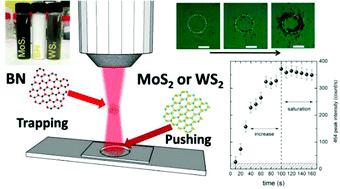
Nanoscale, 2018,10, 1245-1255
https://doi.org/10.1039/C7NR06465A
Interlayer bond polarizability model for stacking-dependent low-frequency Raman scattering in layered materials
A simple model is developed to reveal the stacking dependence of Raman intensities of interlayer vibrations in 2D materials.
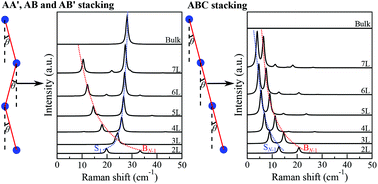
Nanoscale, 2017,9, 15340-15355
https://doi.org/10.1039/C7NR05839J
Plasmon–trion and plasmon–exciton resonance energy transfer from a single plasmonic nanoparticle to monolayer MoS2
Tunable plasmon–trion and plasmon–exciton resonance energy transfer from a single Au nanotriangle (AuNT) to monolayer MoS2 are demonstrated.
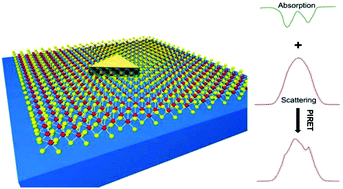
Nanoscale, 2017,9, 13947-13955
https://doi.org/10.1039/C7NR03909C
The optical response of monolayer, few-layer and bulk tungsten disulfide
We present a comprehensive optical study of thin flakes of tungsten disulfide (WS2) with thickness ranging from mono- to octalayer and in the bulk limit.
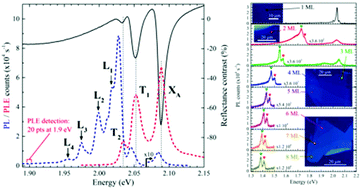
Nanoscale, 2017,9, 13128-13141
https://doi.org/10.1039/C7NR04672C
Raman signature and phonon dispersion of atomically thin boron nitride
The intrinsic Raman signature and phonon dispersion of mono- and few-layer BN have been revealed by both experiment and simulation.
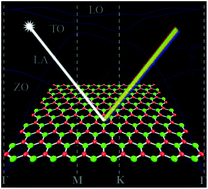
Nanoscale, 2017,9, 3059-3067
https://doi.org/10.1039/C6NR09312D
Near-field spectral mapping of individual exciton complexes of monolayer WS2 correlated with local defects and charge population
Spatial and spectral maps of excitons, trions and localized defect-bound excitons in monolayer WS2 are revealed by near-field imaging.
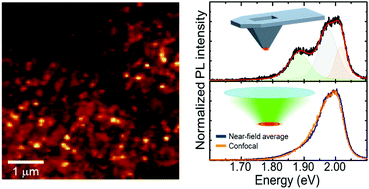
Nanoscale, 2017,9, 2272-2278
https://doi.org/10.1039/C6NR08813A